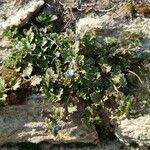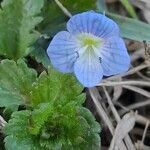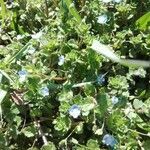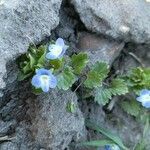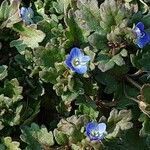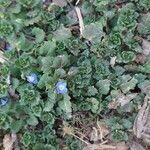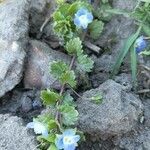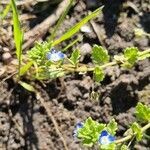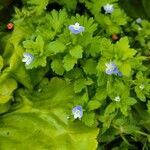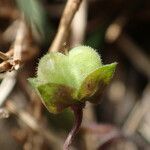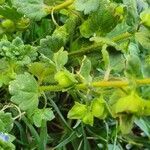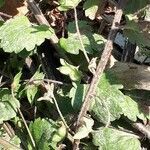Hairy annual; stems much-branched, decumbent, to c. 15 cm long, densely covered with crisped hairs, not rooting at nodes. Petioles to 5 mm long. Lamina 3-8 × 3-8 mm, ovate, often broadly so, or suborbicular, coarsely crenate-serrate, often glabrate above, rather densely covered with crisped hairs below; base truncate or nearly so; apex obtuse. Fls axillary, solitary, in axils of lvs similar to vegetative lvs; pedicels c. 5 mm long, to 8 mm at fruiting, mostly > subtending lvs. Calyx 2-3 mm long, hairy or glabrous; lobes broadly ovate, prominently ciliate, obtuse or rounded. Corolla c. 6 mm diam., ± uniformly blue. Capsule c. 4 mm wide, not deeply lobed; nerves usually inconspicuous; lobes obtuse, ± erect, rounded on outer margin, densely hairy with straight glandular and short curly eglandular hairs. Seed broadly elliptic, concave on 1 face, irregularly transversely ridged on convex side.
Prostrate or occasionally ascending annual herbs, branching at the base, root-ing at the lower nodes, the stems drying angled, sparingly pilose. Leaves opposite, broadly ovate or elliptical, apically obtuse, basally truncate, conspicuously dentate in the upper 2/3, mostly 10-18 mm long, the veins ca. 5, subdigitate, strongly ascending; petiole to 8 mm long, about ?/2 as long as the leaves. Inflorescences solitary flowers in leaf axils near the branch apices; pedicels slender, exceeding the leaves, pilose; bracts not differentiated. Flowers with the calyx divided to the base, the lobes oblong to lanceolate, pubescent, ca. 4 mm long; corolla rotate campanulate, blue with a conspicuous white eye and lines to the center; stamens 2, the filaments stiff, the anthers bluish, the style stiff, the stigma punctiform. Capsule evenly pubescent overall, the carpels plump, ca. 3 mm long.
Much like no. 8 [Veronica agrestis L.]; fls blue; style to 1.5 mm, surpassing the sinus of the fr; fr densely pubescent with long glandular and short eglandular hairs, 2.5–4 × 3.5–6 mm, with rounded lobes, the sinus broader and shallower than in no. 8; 2n=14. Native of Eurasia, now widespread in our range and southward. (V. didyma, misapplied)
A herb.
